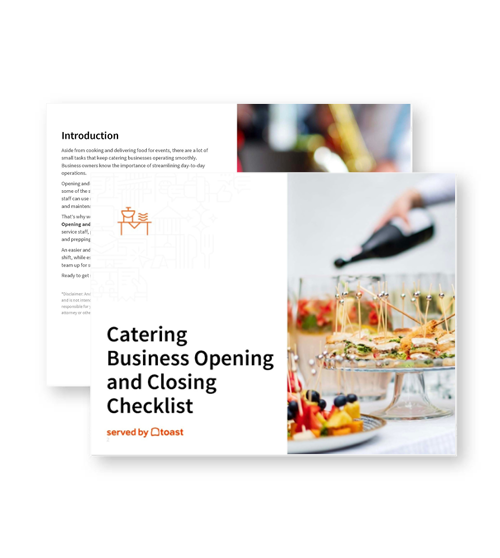
How to Make an Opening and Closing Checklists for Catering Businesses
Opening and closing checklists for catering businesses help staff to keep the kitchen clean and streamline operations.
Tyler MartinezAuthor

Catering Opening & Closing Checklist
The beginning and end of a shift can be frantic. Use this free PDF checklist to set your catering staff up for success.
Get Free Download | Built for Restaurants
| Built for RestaurantsWhat is an opening and closing checklist?
An opening and closing checklist is a to-do list of all the items you must do every day to ensure successful daily operations.
Catering Business Opening and Closing Checklist Guide
Aside from cooking and delivering food for events, there are a lot of small tasks that keep catering businesses operating smoothly. Business owners know the importance of streamlining day-to-day operations.
Opening and closing checklists for catering businesses can take some of the stress and guesswork out of delegating tasks. The entire staff can use checklists to keep up with all of the prep work, cleaning, and maintenance that goes into running a catering business.
Checklists can be divided by job title and kitchen station. Items can be listed in the order they need to be completed to keep everyone working efficiently. And you can create checklists for daily, weekly, and monthly maintenance tasks.
In this article, you’ll learn about why opening and closing checklists are useful for streamlining operations in your catering business. We provide advice about how to build checklists, how to train staff to use them, and list some examples of tasks to include on your opening and closing checklists.
Catering Opening & Closing Checklist
The beginning and end of a shift can be frantic. Use this free PDF checklist to set your catering staff up for success.

What is an opening and closing checklist?
Opening and closing checklists are made of key tasks that should be completed throughout each shift. Opening checklists ensure that the business is set up to run smoothly throughout the day. Closing checklists guide staff on how to set up for the next day and clean the restaurant properly. They help to reduce food waste and maintain food safety standards.
Why do you need a checklist before opening and closing a catering business?
Catering businesses use checklists to keep track of all the daily, weekly, and monthly tasks that need to be completed. Checklists help staff to keep the business clean and operating at peak efficiency, increasing the business's productivity. They can be useful for everyone on the staff, from managers to prep cooks. And checklists help you to ensure that you’re operating within health code regulations.
Easier Training
Checklists help with training new staff members. They help new hires get up to speed faster and keep track of all of the tasks that they are expected to complete. New staff can rely on checklists, rather than their memory, to keep them on task during a shift.
Team Accountability
Opening and closing checklists are great for delegating tasks quickly. Management can create checklists for specific kitchen stations and avoid having to create a plan for each shift. Coworkers and managers can use checklists to split work evenly among members of the team.
Ensures Cleanliness Standards
All food service businesses should maintain clean, sanitary workstations. Checklists help staff to keep track of all the cleaning and sanitizing tasks that need to be completed. That way, nothing gets forgotten or overlooked and you never have to worry (too much) about surprise food safety inspections.
Reduces Mistakes
Catering businesses produce large amounts of products at a time. If a dish takes longer to produce or is unsellable because of a mistake, it is that much more costly. Checklists help to reduce mistakes, saving time and money in the process.
Increases Efficiency
Your staff works together to set the business up for success. If the closing staff misses a task, it can cost the opening shift valuable time. A checklist can help ensure that all catering orders are ready to go on time.
Tips for Creating and Implementing Your Catering Business Opening and Closing Checklists
Brainstorm Tasks
Start creating opening and closing checklists for your catering business by brainstorming all the tasks that need to be completed. List everything that needs to be done that isn’t included in recipes. You can create separate lists for cleaning tasks that need to be completed weekly or monthly.
Consult Your Team
Your business’s management team and long-term employees probably know all the tasks that keep things running efficiently. When you have a first draft of your checklists, consult your staff to make sure nothing is missing. They should be able to help you fill any holes in the list and make a plan to keep every surface and corner of the business clean and sanitary.
Use a Template
Templates can help you to build clear and comprehensive opening and closing checklists for your restaurant. There are templates available for all of your catering kitchen’s stations. It’s important to use precise, easy-to-read language in your checklists so that there’s no question of what list items refer to.
Train the Team
Use the opening and closing checklists to train new team members. And train your existing staff on how to use each of the checklists. Make several copies of each list. You can even laminate them to keep them clean and protect them from spills while allowing your staff to reuse them with dry-erase markers.
Update Often
Every good process takes a few interactions to get it just right. Update your opening and closing checklists as your business grows and changes. You might need to add new items and take others off the lists to keep them relevant. Distribute updated lists so that staff is working with current processes.
Types of Opening and Closing Checklists
Service Staff Opening Checklist
The service staff at catering companies deliver orders and serve food at events. Checklists can help them to make sure that they have everything they need on the job. Here are some tasks to include on service staff checklists:
Clock in
Check the day’s orders and/or deliveries
Gather utensils, supplies, and service equipment
Clean and organize the delivery truck
Create a plan of action for events and/or deliveries
Service Staff Closing Checklist
Unload unused supplies from the delivery truck
Deliver any collected payments to management staff
Clean utensils and service ware
Organize supplies for the next day’s orders
Clock out
Production Opening Checklist
The production staff is responsible for producing completed dishes for catering companies. Here are some tasks to include on production checklists:
Take necessary perishable ingredients out of the walk-in cooler
Pre-heat stoves, ovens, and fryers
Restock stations for production
Arrange utensils and cooking supplies
Weigh out ingredients for recipes
Identify and report any short or missing inventory
Production Closing Checklist
Clean and sanitize all workstations
Clean dishes and cooking equipment
Sweep and mop floors
Turn off ovens, stoves, and fryers
Empty trash and food waste bins
Management Opening Checklist
Catering business managers take orders and make sure that the production staff fulfills them on time. Consider including these tasks on your management checklists:
Review the day's orders and prepare staff to fulfill them
Review the staff schedule for the day
Check inventory and place orders for items with low stock
Answer emails, check Yelp reviews, and post on social media
Pay any bills that are due
Management Closing Checklist
Ensure that the staff properly cleans and sanitizes the kitchen
Check temperatures in all refrigeration units
Review the next day’s orders
Run sales and labor reports for the day
Lock the building and set security system
Streamline Operations with Opening and Closing Checklists
Catering businesses run more efficiently when dozens of daily tasks are organized and completed in a timely manner. Without checklists, it is difficult for cooks and managers to remember all the tasks. Opening and closing checklists take the guesswork and human error out of organizing and cleaning tasks.
These checklists will help you to streamline the daily operations of your catering business so that you and your staff can deliver an excellent experience to each customer.
Related Resources
Restaurant Banquet Event Order (BEO) Template
This free BEO template can help your restaurant optimize incoming catering requests and streamline documentation.

Is this article helpful?
DISCLAIMER: This information is provided for general informational purposes only, and publication does not constitute an endorsement. Toast does not warrant the accuracy or completeness of any information, text, graphics, links, or other items contained within this content. Toast does not guarantee you will achieve any specific results if you follow any advice herein. It may be advisable for you to consult with a professional such as a lawyer, accountant, or business advisor for advice specific to your situation.
Read More
Subscribe to On the Line
Sign up to get industry intel, advice, tools, and honest takes from real people tackling their restaurants’ greatest challenges.
By submitting, you agree to receive marketing emails from Toast. We’ll handle your info according to our privacy statement. Additional information for California residents available here


